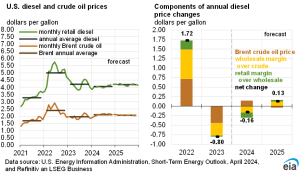EIA’s ho-hum 2024-2025 energy forecast
Posted on April 15, 2024 by admin
When it comes to overall U.S. energy trends, this year and next will look much like 2023, according to the Energy Information Agency’s Short-Term Energy Outlook, released last week (April 9).
According to the Department of Energy’s statistical arm, worldwide crude oil prices, which averaged $82 per barrel in 2023, will rise slightly to $89 in 2024 and decline to $87 in 2025. That translates into average gasoline prices, currently at about $3.50 per gallon, rising slightly to $3.60 this year and the same in 2025.
U.S. gasoline prices spiked at nearly $5/gallon in July 2022, fell to about $3 this January, and have stabilized at around $3.50. EIA cautions, “Retail and distribution margins can reflect a wide variety of factors including taxes, wages, and regional and logistical complications.”
U.S. crude oil production, 12.9 million barrels per day in 2023, likely will increase to 13.2 million daily barrels this year and 13.7 million in 2025.
For natural gas, the 2023 Henry Hub average price of $2.50 per million Btu will be at $2.20 per mmBtu in 2024 and $2.90 in 2025. U.S. liquefied natural gas exports (the U.S. is the world’s largest LNG exporter, 12 billion cubic feet per day in 2023), will stay at 12 bcf/d this year and rise slightly to 14 bcf/d in 2025. According to EIA, “In 2025, LNG exports increase by an additional 2 Bcf/d (18%) because three of the five LNG export projects currently under construction are expected to start operations and ramp up to full production.” In other words, EIA does not expect the Biden administration’s current halt on DOE approvals for new LNG terminals to have a effect.
EIA also expects pipeline gas exports will increase by about 1 bcf/d over the forecast period “mainly because of increased natural gas exports to Mexico. We expect several pipelines in Mexico— Tula-Villa de Reyes, Tuxpan‒Tula, and Cuxtal Phase II connecting to the Energía Mayakan pipeline on the Yucatán Peninsula—to reach full service in 2024‒25.”
The sources of electric power won’t change much over the next two years, according to EIA. Gas will continue at the top of the heap, as its 42% share of the generating mix will remain at 42% in 2024 and dip slightly to 41% in 2025. Coal will continue to slide, from 17% in 2023 to 15% in 2024 and 14% in 2025. Nuclear will remain at 19% throughout the analysis.
Renewables show the greatest growth in EIA’s forecast, rising from 21% this year to 24% next year and 25% in 2025. EIA says, “In particular, the electric power sector added 19 gigawatts (GW) of solar capacity in 2023 (a 27% increase), and we expect 37 GW will be added in 2024 and another 32 GW will be added in 2025. With this new capacity, we expect solar will provide 6% of total U.S. electricity generation in 2024 and 7% in 2025, up from a 4% share in 2023. The increased generation from solar is likely to slow growth in generation from natural gas-fired power plants, even with relatively low natural gas prices in the forecast.”
U.S. electricity sales “will increase by 2% in 2024 compared with 2023 and by 1% in 2025,” according to EIA. “The expected growth contrasts with a 2% decrease in electricity sales in 2023 compared with 2022. We expect electricity consumption to grow in all major consuming sectors this year, with forecast growth especially strong in the residential sector, where we expect it to increase by 4%. Much of the forecast year-over-year growth in residential electricity occurs this summer. We expect a hotter summer this year, with 7% more forecast cooling degree days in 2Q24 and 3Q24 than the same quarters in 2023.”
“Areas of the country with concentrations of new large computing customers, such as data centers, have the fastest forecast growth in total non-residential electricity consumption”
Electricity sales to non-residential customers will show the greatest growth, says EIA. “Areas of the country with concentrations of new large computing customers, such as data centers, have the fastest forecast growth in total non-residential electricity consumption; we expect the West South Central and West North Central Census Divisions together will contribute 50% of total U.S. non-residential electricity sales growth in 2024 and almost 90% of growth in 2025.”
The collapse of Baltimore’s Francis Scott Key bridge will have a clear but short-term effect on U.S. coal exports. Because the destruction of the bridge cause Baltimore harbor to shut down, EIA said it “reduced our forecast for U.S. coal exports by almost 3 million short tons (MMst)—more than 30%-in April and 2 MMst—about 20%–in May compared with the March STEO.
“The port is the second-largest export hub for coal in the United States. We do not expect this event to have a significant long-term impact on U.S. exports coal exports. The price and quality of coal are important factors contributing to international demand for U.S. coal, and we assume some coal previously exported from Baltimore will be shipped from other U.S. ports.”
–Kennedy Maize






![Tesla reviewer breaks down the price of owning an EV versus a gas car in the US: 'Real costs after one year [of] ownership'](https://energynews.today/wp-content/uploads/2023/06/yahoo_news_en-US_s_f_p_168x21_news-90x21.png)





